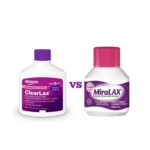Can I Give My Dog MiraLAX For Constipation?

Constipation is a common health problem in dogs and refers to the inability to pass a normal stool on a regular basis. This can happen for different reasons and usually can be easily fixed, but some dogs may experience chronic constipation. This can lead to obstipation where the stool becomes drier, harder, and compacted and the dog can’t defecate at all.
Causes of Canine Constipation
In normal digestion, waste is full of water and electrolytes as it is pushed through the intestines to the colon by an automatic muscular motion called peristaltic waves. The water is absorbed in the colon and the waste is moved out as a stool.
If this process becomes slow or impaired, the colon will keep absorbing water and the stool will become harder, drier, and possibly compacted.
Some of the most common causes of constipation in dogs include:
- Lack of exercise
- Poor diet
- Not enough fiber
- Blockages from eating non-food items like garbage, bones, gravel, or plants
- Too much self-grooming that leads to hair collecting in the stool
- Age
- Hypothyroidism
- Renal issues
- Enlarged prostate
- Anal gland problems
- Dehydration
- Spinal injury
- Certain medications
- Surgery
- Stress
- Tumors
- Trauma to the pelvis
- History of constipation
Symptoms of Dog Constipation
Symptoms of dog constipation include:
- Lack of defecation for a few days
- Hard, pebble-like stool
- Straining without producing much stool
- Discomfort
- Painful defecation
- Difficult defecation
- Mucus with stool
- Bloody stool
What is MiraLAX?
MiraLAX is a brand-name, over-the-counter (OTC) medication. It’s classified as an osmotic laxative. MiraLAX is used to treat constipation. It’s typically used for short-term treatment, but in some cases, it’s used long-term to treat chronic (long-lasting) constipation. MiraLAX is also sometimes used for colonoscopy bowel preparation.
In Humans, taking MiraLAX will cause a bowel movement within one to three days of taking it. One study of its effectiveness focused on people who had fewer than two bowel movements per week. MiraLAX increased their number of bowel movements to 4.5 per week, compared to 2.7 per week in people taking a placebo. Another study found that 52 percent of people with chronic constipation were successfully treated with MiraLAX.
MiraLAX comes as a flavorless powder that you mix with four to eight ounces of water, juice, or other liquid. The powder comes in bottles or single-serve packets.
Can I give my dog MiraLAX?
Yes, you can give MiraLAX to your dog for short term treatment of constipation. Veterinarians sometimes prescribe an approved human drug in animals in certain circumstances. This is called an extra-label use. MiraLAX works by colon nerve stimulation in your dog. Consequently, the muscle contracts, pushing the feces through the dog’s colon. As an osmotive laxative, MiraLAX makes it much easier for your dog’s stool to be transported through its digestive system by making it less dry and compact. Miralax works best when used in relieving occasional constipation.
However, it is strongly recommended that you consult your vet before administering Miralax on your dog for constipation.
How Long Does It Take for MiraLAX to Work on a Dog?
Typically, your dog should start experiencing improved bowel movement 24-72 hours after administering Miralax. If after this period, you still notice the severity of constipation, it could be suggestive of a serious underlying health condition.





